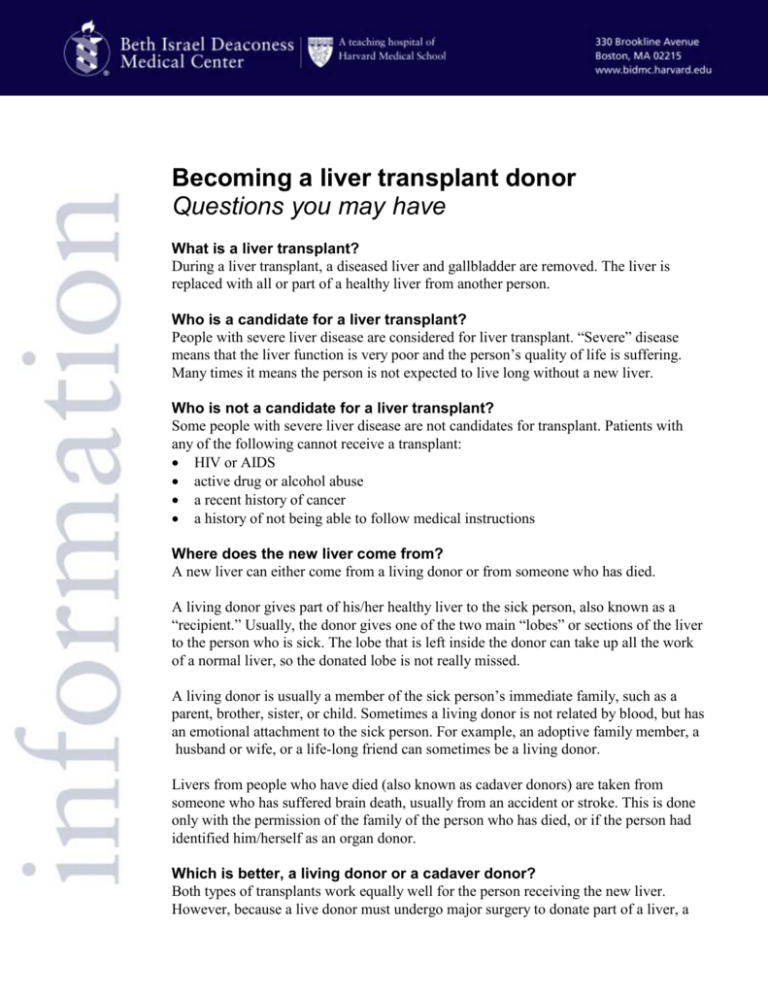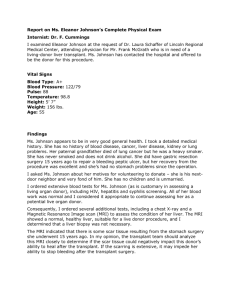
Becoming a liver transplant donor
Questions you may have
What is a liver transplant?
During a liver transplant, a diseased liver and gallbladder are removed. The liver is
replaced with all or part of a healthy liver from another person.
Who is a candidate for a liver transplant?
People with severe liver disease are considered for liver transplant. “Severe” disease
means that the liver function is very poor and the person’s quality of life is suffering.
Many times it means the person is not expected to live long without a new liver.
Who is not a candidate for a liver transplant?
Some people with severe liver disease are not candidates for transplant. Patients with
any of the following cannot receive a transplant:
HIV or AIDS
active drug or alcohol abuse
a recent history of cancer
a history of not being able to follow medical instructions
Where does the new liver come from?
A new liver can either come from a living donor or from someone who has died.
A living donor gives part of his/her healthy liver to the sick person, also known as a
“recipient.” Usually, the donor gives one of the two main “lobes” or sections of the liver
to the person who is sick. The lobe that is left inside the donor can take up all the work
of a normal liver, so the donated lobe is not really missed.
A living donor is usually a member of the sick person’s immediate family, such as a
parent, brother, sister, or child. Sometimes a living donor is not related by blood, but has
an emotional attachment to the sick person. For example, an adoptive family member, a
husband or wife, or a life-long friend can sometimes be a living donor.
Livers from people who have died (also known as cadaver donors) are taken from
someone who has suffered brain death, usually from an accident or stroke. This is done
only with the permission of the family of the person who has died, or if the person had
identified him/herself as an organ donor.
Which is better, a living donor or a cadaver donor?
Both types of transplants work equally well for the person receiving the new liver.
However, because a live donor must undergo major surgery to donate part of a liver, a
cadaver donor is always the first choice. Living donation is considered on a case-by-case
basis. For example, if the patient is too sick to wait for a cadaver donor, a living
donation may be considered.
How is the donated liver used?
If the liver is from a cadaver donor, it can be used in two ways:
The entire liver is used in one person.
The liver is split between two recipients. The right
lobe, which is larger, goes to an adult. The left
lobe goes to a child or a small adult.
If the liver is from a living adult donor:
The right lobe is used if the recipient is an adult.
The left lobe is used if the recipient is a child.
right lobe
left lobe
How is the living donor chosen?
Living donors must meet certain requirements. Some
of the most important ones are listed here.
In general, the donor’s blood type should be the
same as the recipient’s.
The donor must be close in size, or larger than, the
recipient.
The donor must be between the ages of 18 and 55.
The donor must be in good physical and mental health. This means:
no active alcoholism or frequent, heavy intake of alcohol
no psychiatric illness under active treatment
no history of cancer, other than skin cancer
no heart or lung disease requiring medication
no diabetes for longer than 7 years
no known viral hepatitis or HIV infection
not seriously overweight
If I want to be a liver donor, what will I need to do?
If you want to be a liver donor, you will begin a “donor evaluation” here at the medical
center. At the end of this evaluation, we will know if you are able to be a liver donor.
As a first step, you will be asked to fill out a form with information about your
health history and blood type. After we review your form and determine that you
don’t have any major medical problems and that your blood is the right type for the
recipient, we will schedule you for a visit with one of our doctors. This doctor will
gather more medical information and complete a thorough exam. Blood and urine
tests will be done at this time to make sure there are no hidden medical problems.
You will also meet with a psychiatrist who will talk with you about the emotional
aspects of being a liver donor.
If all the information from this exam indicates you may be a suitable donor, we will
then schedule you for a CT scan (sometimes called a CAT scan) of your abdomen.
This is done to make sure your liver is the right size for you to be a donor. We must
make sure part of your liver will fit into the recipient, and also that you will have
enough left for yourself.
If your liver is the right size, we will need to do a “needle biopsy” of your liver. This
is an outpatient procedure in which a small needle is inserted into your abdomen and
a very small piece of the liver is taken out for exam. By looking at this small sample
in the lab, we can make absolutely sure that your liver is healthy. You will need to
stay at the hospital for several hours for this test.
Once these steps are completed, our liver transplant team will meet and discuss the
results. Based on all the information from your evaluation, the transplant team will
make a decision about whether you will be able to be a liver donor.
If I am found to be a suitable donor, what happens next?
We will arrange a meeting between you, the recipient, and the transplant team. At this
meeting, we will talk about when the transplant could be done, and we will answer any
questions you or your families may have. Once the surgery date is set, you will be
scheduled for routine pre-operative tests, such as chest x-ray and ECG. Near the time of
your surgery, you will meet with an anesthesiologist. You will also received detailed
instructions about things you need to do to prepare for your operation.
What will happen on the day of surgery?
Most likely, you will be admitted early on the morning of surgery. You will see doctors
and nurses who will help prepare you for your operation. The surgery will then begin.
This surgery usually lasts about 4 or 5 hours. The surgery on the recipient is taking place
at the same time and generally lasts a bit longer, about 6-8 hours.
How is the donor operation done?
The surgeon will make an incision in your abdomen. The incision is
large, and runs across the upper part of your abdomen (see picture). The
surgeon removes the lobe of your liver that is being donated. The lobe is
taken to the room where the recipient is in surgery. Then the surgeon re-constructs the
area around the lobe that is remaining so that it can work normally.
Is the operation risky?
The donor surgery, also called a “partial hepatectomy,” is very safe when it is done in a
center that performs a lot of liver surgery. Complications are rare, occurring in less than
5% of cases. However, as with any major surgery, difficulties can arise. These will be
discussed in detailed when you meet with the surgeon.
How long will I be in the hospital? How long will I be out of work?
Most donors stay in the hospital for about 4-5 days after surgery. Recovery is generally
rapid. Most donors get out of bed the day after surgery.
Recovery time at home varies. Your surgeon will tell you when it is OK to return to
your usual activities. In general, this recovery period is 6-8 weeks, but in some cases it
is as long as 3 months.
After discharge from the hospital, donors are followed closely by the surgeon in the
transplant clinic. Most donors come back to the office weekly for the first two weeks,
then every other week for the next two weeks. Donors then come for follow-up every
three months for the first year after their surgery and then annually. Liver function tests
as well as periodic CT scans are done on the days of the clinic visits to monitor posoperative liver function and liver regeneration.
Who pays the donor’s hospital costs?
The recipient’s health insurance normally covers the costs of the donor’s care before,
during, and after the surgery. Our financial coordinator will review all the costs with the
recipient’s insurance company to get approval before the surgery is done.
If you have more questions, or think you might like to be evaluated as a living donor,
please call our program office at 617-632-9700 and ask for the liver donor coordinator.
This material was prepared by the clinicians from the transplant service at Beth Israel Deaconess Medical Center. It is produced and
distributed by The Beth Israel Deaconess Learning Center. ©2004, Beth Israel Deaconess Medical Center. All rights reserved.
MC0779 Rev. 10/2004






